A Short Diversion in Kiruna
Seeing as how launching this balloon is now old
hat, we thought to
ourselves "Well, we can't do that again... I mean where's the challenge?"
"Aha!" we countered, "what if we do again, but this time we do it in
Swedish!"
And what a better time to do it again, in Swedish, but during a short
diversion in Kiruna, Sweden?
[ bottom | oldest first | panoramas | See also: Gaelen's log ]
Fri 2005-08-05 22:01:10 UTC
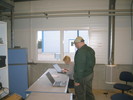
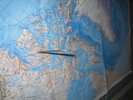
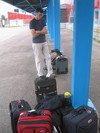
Well here, finally, are the pictures from the end of the campaign. Sorry for
the delay. After leaving Kiruna, Gaelen, Marie and I spent the weekend in
Stockholm as planned, after that I flew to London for a few days before heading
home. I have pictures from both Stockholm and London that I'll have to upload
at some point.
Fri 2005-06-17 09:01:13 UTC
Sorry, no pictures. All our computer equipment is packed up.
It's Friday morning and essentially everything has been packed up. BLAST
terminated around 06:00 UTC yesterday morning. Once we had hit land over
Victoria Island our speed dropped dramatically (to about 15 knots), and the NSBF
Operations Control in Palestine, Texas kept phoning us to delay termination.
Ed and David had a bit of work to find more fields for us to scan, so as not to
waste the extra time.
It came as a bit of a surprise when we were phoned back asking us to shut down
for termination as quickly as we could: the balloon had taken an unexpected
turn to the south, leading us into an area of the island full of lakes, instead
of the more northerly plateau that we had planned on putting down on. We
hurriedly shut down the telescope and were then immediately terminated: BLAST
and the parachute were separated from the balloon and falling to Earth.
Here followed another tense hour or so as we watched the telescope's descent,
wondering if we'd land in one of the many lakes which satellite photography
told us was there. Eventually we got a call from Palestine telling us that
the payload had landed and that they were still receiving telemetry from it,
a good sign: it meant that the SIP was still working so the telescope had likely
not landed in a lake or been dragged over the ground.
So that's the end of the flight, we're still waiting on word on recovery to
see how much damage the gondola has suffered, especially the mirror. Mark and
Jeff probably won't know for a few days. We're almost finished packing up and
people have started to leave. Enzo, Katia and David left Thursday evening,
Matt took off this morning and the rest of us (Gaelen, Marie, Barth and I)
will be heading for the airport after lunch today. Gaelen, Marie and I plan
to spend the weekend in Stockholm, doing some sightseeing and recuperating
from our ordeal before heading back to North America. I'm also hoping to get
a chance to spend a few nights in England, visiting a friend. Hopefully I'll
get a chance to upload a final bunch of pictures once I get back to Toronto.
Wed 2005-06-15 17:13:27 UTC
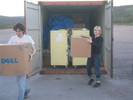
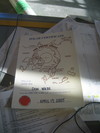
It's Wednesday evening here. We're maybe eight hours from termination of the
flight over Victoria Island. Conditions there are overcast and it's sleeting.
Mark and Jeff are up there, awaiting termination.
The past few days have been long and frustrating. Ed has been kept really busy
rescheduling our observations at least once a day. The rest of us have been
kept occupied by alternately monitoring the gondola's health or packing up the
high-bay.
Everyone's sleeping schedule is slightly different, but we basically have two
shifts: Gaelen, Marie and Matt on the one shift and the rest of us on the other.
Other than occasionally sleeping and eating, we've been in the high-bay working,
which has made the shifts rather long.
Our speed over Canada has remained high (> 30 knots) and we'll likely be cutting
down almost a day earlier than we had hoped. When we have had nothing else to,
we have all been worrying about our travel plans.
Tue 2005-06-14 03:26:01 UTC
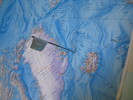
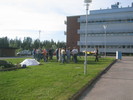
It's early (05:00) Tuesday morning. I got to sleep around midnight last night
and slept fitfully until about 06:30. Arriving in the lab, I discovered that
I had missed the excitement that had resulted from an electrical storm in
Palestine, which brought our link to the gondola down for some time. More
network outages both here, and in Palestine have kept me busy.
BLAST's flight path still looks good. It's been travelling basically west, with
small diurnal fluxuations. (The telescope tends towards the sun, which
revolves once a day. So, in the evening the telescope drifts northwards, and in
the morning it drifts back southward.) We're currently over Greenland and we're
estimating another three days of flight from now.
Enzo, Ed and Barth have been working on making maps from the line-of-sight data
from which we can extract sensitivity and beam size measurements. Our estimates
of the sensitivity is lower than expected, which has meant that we need to
control the telescope manually from the ground rather than just letting it run
automatically. Because of this, the losses in the network between here and
Palestine have been especially alarming, since when the network is down, we
can't command the telescope.
In the evening Esrange held a party for us and the NSBF crew, who are leaving
Wednesday.
Sun 2005-06-12 15:01:46 UTC
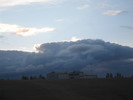

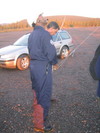
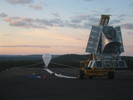
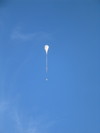
It's 17:50 (local time) Sunday evening. BLAST has been up in the air for about
fourteen hours now. We launched just after 01:00 UTC and reached float around
04:00 UTC at an altitude of 39 kilometres (129,000 feet). This is higher than
we expected and rather nice, since it means that much less atmosphere to look
through.
People have over the past few hours finally staggered off to bed, after
twenty-four or more hours being up. The only ones left here are Barth, Enzo and
I. I've been hanging around until line of sight telemetry dies, which is just
has, with the balloon 620 km (385 miles) to the west, over the Norwegian Sea.
On the whole things have been performing well. Our ascent was rather slow,
which was initially a problem since we got really cold when going through the
tropopause, freezing some of our electronics. After some time at float,
however, staring at the sun, things seems to have thawed out, and started
working again. The other thing of note, which gave Barth something to worry
about during ascent was the remaining charge in the flight batteries. Since
we spent so long on the flightline before launch, the batteries got depleted
more than we had anticipated. If they had run out of power before we got
to float, we would have been in trouble. Because of this, we started pointing
in azimuth significantly before we got to float, in an attempt to keep the
solar panels pointed at the sun. This, it turned out, was a good thing to do,
and we were able to recharge the batteries.
These first hours while we're within line-of-sight have been spent trying to
characterise the telescope as much as we can. Enzo and Ed have already made
some impromptu maps, but we need some more time (and sleep) to get a real idea
of what our beam looks like.
The other excitement for the day was the loss of our Internet connection. The
fibre between Esrange and Kiruna was cut somehow stranding us here without
access. More serious than me not being able to upload the accompanying launch
video, we need Internet to be able to connect to our computer in Palestine which
is our only link to the gondola once our line-of-sight transmitters die. I
spent a frantic few hours with Chris Field of NSBF and a couple of the Esrange
guys who had been up as long as us to try somehow patch into the net. In the
end, Esrange managed to give us a temporary patch through Stockholm until the
cable gets repaired, something for which we were very grateful.
Mark and Jeff are planning to leave early Monday morning to make their round
about way to northern Canada for the recovery. Paul will also leave tomorrow
and hopefully be able to meet Mark and Jeff for recovery. The NSBF crew are
already deep into packing and departing themselves. The rest of us will stay
here for the rest of the week, following BLAST's progress until we terminate.
And, now that we've lost line of sight, I'll head to bed and get a few hours of
sleep...
Sat 2005-06-11 18:14:12 UTC
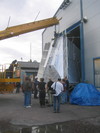
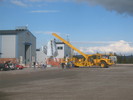
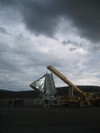
It's quarter after eight Saturday evening. We're still waiting to go out to
the flightline. The new estimated launch time is midnight local time. The
winds have been calm, but a small rain cloud just passed over the pad, so we're
now trying to dry everything out.
The helium tanker and spool have already made the trek out to the finger to
set up there, which seems like a promising sign. The riggers are starting to
think about putting down the ground cloths, which is the first step in rolling
out.
Also, mosquito season seems to have just started in the last hour or so.
Update: 01:24 UTC
We've just launched successfully. We're at five kilometres and climbing at five
metres a second. I'll have photographs and my launch video later, but right now
my camera's battery needs to spend a bit of time recharging.
You can get live GPS data from the payload at the NSBF's tracking site.
Sat 2005-06-11 13:44:05 UTC
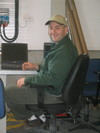
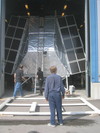
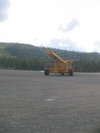
It's quarter to four Saturday afternoon and we're getting ready to be picked up
for our second launch attempt. We're trying to get outside on the flightline as
quick as we can and then we'll wait to see what happens. Estimated launch time
is 21:00 local time (19:00 UTC). Everyone seems optimistic. I forgot to
mention that there's a streaming video of the pad from up on Radar Hill. It
should be accessible from http://iptv.esrange.ssc.se/.
Fri 2005-06-10 23:48:08 UTC
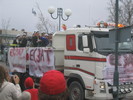
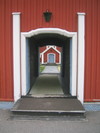
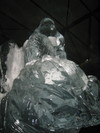
Friday night. The forcast still seems favourable for a launch attempt tomorrow,
at about two in the afternoon.
Today Marie and Ed went into town to get a hair cut. Matt and I tagged along.
In town we met up with a parade of high school graduates who were celebrating
the end of the school season. It appeared to be quite a community event.
After the haircutting, we drove back to Jukkasjärvi, the town between Esrange
and Kiruna where the world-famous Ice Hotel is made each winter. We arrived in
northern Sweden just as the Ice Hotel was closing, so we never got to see the
inside of it, however, it's bones still remain, melting chunks of snow and ice
next to the Torne River out of which it was created. Gaelen and Paul met up
with us and we looked around the Jukkasjärvi Church and then took a tour of the
Ice Hotel site. In addition to the strand along the river where the Ice Hotel
is built, they have also a large building which they cool to -8°C year round.
During the winter it is used as a construction workshop. Now they had an
exhibit of ice scupltures based on the works of the Swedish illustrator John
Bauer there. The sculpture work was quite impressive.
After the tour, all of us save Paul, who had a prior engagement, ate a wonderful
dinner at the Restaurang Hembygdsgården (Old Homestead Restaurant in
English) in Jukkasjärvi.
Thu 2005-06-09 16:33:09 UTC
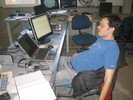
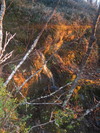
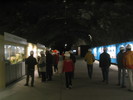
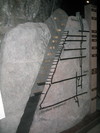
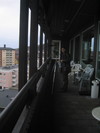
It's Thursday afternoon. There was no launch Tuesday due to high low level
winds. We're looking at another all-day launch day Saturday.
I went to bed Tuesday morning when Mark, Jeff, Marie and Gaelen came in to get
things ready for the launch. When I woke up again shortly after noon, our
pick-up time had been pushed back to seven in the evening at the earliest. Most
everyone in the group had returned to Dagobert for some sleep, anticipating
being up all night.
We all got together at five, after an early dinner to prepare, but after working
on this for a bit, Ross, the meteorologist had bad news for us: although the
surface winds would drop down to acceptable levels by around midnight
(acceptable being 4 to 5 knots), the low level winds (at an altitude of, say,
Radar Hill) would remain too high. The launch attempt was scrubbed. To give
us something to do, Barth, Gaelen, Marie, Matt and I walked up Radar Hill around
midnight and verified that it was indeed windier up there than it was lower
down. Instead of walking back down the road, Gaelen suggested we take a short
cut right down the side of the hill back to the base. If it was shorter in
distance, it probably wasn't in duration. It was certainly more scenic.
As a diversion, we organised a mine tour for Wednesday. Gaelen, Marie, Matt, Ed
and Paul went in to town for lunch. I didn't go with them because I was still
asleep due to my odd schedule. Instead I went in with Jeff and David around two
to meet up with the others. We then headed for the mine tour which started
around three and lasted about three hours. It's an impressive mine and the tour
was enjoyable. After the tour we went out for dinner at the Ripan Restaurant
up on Luossavaara (Salmon Mountain), behind the city.
Today has been quiet so far. Most of us are taking it easy, anticipating a
busy weekend.
Mon 2005-06-06 23:59:52 UTC
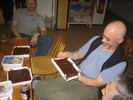
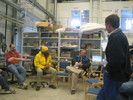

It's Monday night and we're gearing up for our first launch attempt.
Saturday night we had a birthday party for Mark. Marie and Matt had baked
brownies for the occasion. Immediately following this I went to sleep, since
I had been up for about twenty-three hours by that point. I woke up shortly
before seven for the road trip, but in the end we decided to forgo it, on the
off chance that we had a launch opportunity Sunday or Monday.
Sunday it rained all day, and things were very uneventful. In the afternoon
we had a weather briefing and the forecast was for a launch window opening up
some point in the eighteen hours between noon Tuesday and six Wednesday morning.
So we've spent the day today doing final tasks and tests. The NSBF crew will
come in around seven to get their stuff ready. Some of us will be in before
that to do a final balancing, a final cryogen transfer and other necessary
pre-flight tasks. In the morning, too, we will hopefully learn from the
meteorologist when during the eighteen hours the launch window will be.
Most of the crew here has already left. Ed and David still remain, writing the
final flight plans, and Jeff is here too. I stayed late last night and woke
up late today, but I should head to bed shortly.
Mon 2005-06-06 20:41:33 UTC

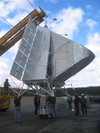
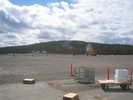
Saturday:
We rolled outside again for another attempt at a hang test Saturday morning as
we never got another chance on Friday. The clouds were dark and looming, but at
least it wasn't actually raining at the time. We were, naturally, all eager to
see the end of this hang test. One thing we did manage to test sufficiently on
Friday was our beyond-line-of-sight telemetry (TDRSS and Iridium) so we didn't
have to do that again Saturday. Most of the tests were performed right outside
the door, a hedge against sudden rain and a rushed re-entrance to the Cathedral.
Despite a few alarming (but short) sprinkles, we manged to cross off almost all
of our tests on the list. The last test, testing the line-of-sight receiver
up on Keops Hill, required us to venture out to the other side of the pad, which
put us that much further from the safety of the highbay in the event of a
surprise storm. But, that test went fine as well and we finished up the
hang-test around two. After a well deserved lunch, there was a weather
briefing. The forecast: no launch window before Tuesday night.
There were then talk about some of us, including Paul, taking another trip out
west to the fjords for a day or two as a break. After some discussion, it was
decided that we would leave early Sunday morning, instead of Saturday afternoon
as we had originally been thinking. Part of this decision was due to me being
unable to leave Saturday afternoon, having been awake since 22:00 on Friday
night.
Fri 2005-06-03 07:31:19 UTC
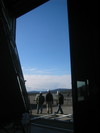
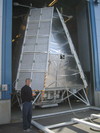
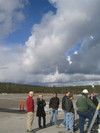
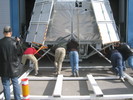
It's 09:30 on Friday. We rolled out shortly after seven to the hang test, but
discovered a small rain cloud looming over Radar Hill soon after so we're back
inside for the time being. Once this rain cloud passes over, we'll see about
trying to go outside for the hang test again.
Fri 2005-06-03 04:42:14 UTC
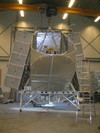
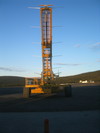
It's Friday morning. The hang test didn't happen yesterday due to weather.
Instead we finished buttoning up and Enzo did some noise tests in the evening.
Esrange hosted a party for us in the evening as well. I spent the night
babysitting a long scan of the roof whilst taking care of a few odds-and-ends.
Enzo and Ed will try to make a map of the roof scan to test their map making
code. Phil Mauskopf arrived today.
People have started to arrive now for attempt two of the hang test, which will
commence around 07:00. It looks a lot more promising today as it doesn't happen
to be snowing.
Thu 2005-06-02 04:32:10 UTC

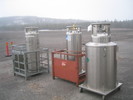
It's Thursday morning; we've planned a hang test to start about 10. Hopefully
I'll be alseep by the time it starts. (I'm still working nights.) We're having
some spotty snow flurries right now.
Most of the remaining hardware tasks were done on BLAST today. The wings and
chin were mounted again, the mylar floor was installed, the motorised valves for
the cryostat were mounted and tested.
In the evening, Ed and I worked a bit on testing data coming from the star
cameras. Enzo removed opened up and fixed up the lock motor again. Ed and Enzo
performed some tests to see how close we could point towards the sun before the
secondary was illuminated by the sun.
Tue 2005-05-31 19:56:47 UTC
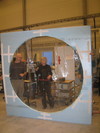

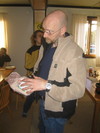
It's Tuesday night. We're just finishing up some alignment tests.
By Sunday the cryostat was cold so the bandpass and alignment tests where done.
Yesterday (Monday) the cryostat and associated electronics were remounted, again
hopefully for the last time. Following this was the standard cryostat alignment
procedure which took a good part of the day. In the evening Gaelen, Marie and
Matt remounted the star cameras, which had to be removed to insert the cryostat.
Following this, Barth scanned the telescope across a dewar of nitrogen that
we placed high up above the second floor offices. This test confirmed the
cryostat alignment tests which told us that our beam was ever so slightly askew,
but nowhere near as bad as it had been the last time we tried this.
The sun shields were reattached today and we began doing final preparations for
launch. In the afternoon Barth's nitrogen bucket test was repeated but at a
farther distance. Since the bucket was further away, getting it high enough so
that we could scan it with the telescope was a bit of a problem. We were
required put the lift truck out on the pad and then send Jeff up in it with the
bucket, which let us look out the door at it. Matt is doing a further series of
such tests tonight, back again on top of the second floor offices.
While we were looking out the door, we also did our star camera to telescope
alignment procedure where Mark and company go out to Radar Hill and we shine
a laser at them. They then shine a flashlight back at us, which we can see in
the star cameras, and from which we can deduce the offset.
Tomorrow we have slated the final buttoning up of the telescope before we are
flight-ready. Thursday, then, we will probably have a hang test and after that
we should be flight ready. Our first flight opportunity seems to be on the
weekend.
Sat 2005-05-28 15:15:50 UTC
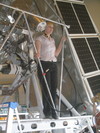
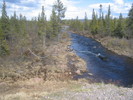
It's Saturday afternoon, we're just about to head to town to catch the latest
installment of Mr. Lucas's Star Wars at the local movie theatre. The past few
days have gone quickly, with little excitement. Let me try to summarise.
Wednesday was BLAST Media Day. What this meant is Mark, Barth,
Danny Ball, Site Manager for NSBF, Olle Norberg, Head of Esrange and Thomas
Hedqvist, our Esrange Campaign Manager held a press conference just after lunch
to talk about BLAST. After this, everyone came over to the Cathedral where we
introduced the media to the telescope. BLAST made it on page 15 of the local
paper.
Thursday was slow. There wasn't much to do but wait for the
cryostat to cool. Barth, Matt, Marie, Gaelen and I went grocery shopping in the
afternoon. Mark, Jeff, David and Itziar left early Thursday morning for a two
day trip to Lofoten in Norway. Mark's brother Paul arrived in the evening.
He's here to hopefully film the launch, as well as everything leading up to
that. Matt, Ed and I ended up heading up to Radar Hill late in the evening
where a small party had been held by the satellite operators and technicians up
there to mark the brief pleasant period between the end of the snows and the
start of the mosquito season.
Friday had little of importance happen other than Mark, Jeff,
David and Itziar returned in the late afternoon. In the evening we had another
planning meeting to identify outstanding issues before being flight ready.
We didn't have much planned for today (Saturday) either. Barth
is taking the day off and has organised the trip into Kiruna to see the film
tonight. Mark supervised the construction of a primary mirror sized window for
beam mapping, similar in construction to the plastic and pink
foam window we had made a few days ago to stand in for the secondary.
During the course of construction, Gaelen cut his hand and had to be taken to
the hospital in town for stitches. Luckily nothing important was cut, although
he isn't feeling up to seeing the film with us.
This whole time, when we have nothing else to do, Ed and I have been running
schedule files to test the flight software. We've encountered the odd bug along
the way, but on the whole things have been going smoothly.
Thu 2005-05-26 10:30:48 UTC
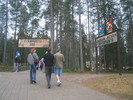
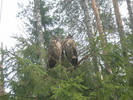
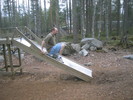
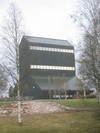
Tuesday:
We got up early to leave for Ranua. This was somewhat problematic
since I had been working nights recently and had only woken up around four in
the afternoon on Monday. Nevertheless I managed to take a nap during the night.
We got on the road shortly after 7. Our route took us from Kiruna to Pajala and
then across the Finnish border into Pello. We then headed for Rovaniemi where
we had a bit to eat in the northernmost McDonald's. We got to Ranua Zoo around
two in the afternoon, an hour later than we had anticipated since we had
forgotten about the time change between Sweden and Finland. Nevertheless we
found the zoo to be of a good size to fill the two hours before it closed
without having to really rush or skip anything. The zoo itself was a pleasant
experience and filled with local wildlife. The majority of it is navigated on
boardwalks which weave among the trees of the forest in which the zoo has been
constructed. The pleasant walk in the woods was nice, even without the added
novelty of the zoo animals. For specifics on some of the strange beasties we
met in Ranua, please see the gallery page.
Since the opportunity presented itself, we decided to take an alternate route
back to Kiruna, travelling west to Simo on the Gulf of Bothnia, and then
following the coast until meeting up with the E10 in Sweden again. Along the
way, we stopped in Kemi to allow Ed to throw rocks into the Gulf, in Haparanda
to take a picture of a odd looking church, and in Kalix to have a tasty dinner
at a wine bar and cafe. In the process of having dessert here, we discovered
a local delicacy: the cloud berry. Turning away from the Gulf, we headed back
north along the E10 to Kiruna, and had another brief stop at the Arctic Circle
Centre which was, unfortunately, closed.
Mon 2005-05-23 22:04:37 UTC
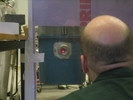
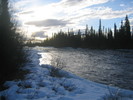
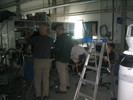
It's Monday evening. It's been a fairly slow couple of days for me. Most of
the activity of late has centred around the cryostat. The weather has been
quite pleasant, with only a little rain to break things up.
Mark and Jeff, with help from many of the rest of us, spent the weekend trying
to figure out what was wrong with the optical alignment in the cryostat. They
put a small light inside the cryostat and then closed it up. This allowed them
to visually check how the light travelled from the bolometer arrays off all
the mirrors and out the window in the cryostat. It was then cooled down to
liquid nitrogen temperature (about -200°C) to see if the change in temperature
made any change in the optical alignment. No shift was discovered, which is
what we expected, but it still left us stymied as to what was misaligned.
Today Peter Hargrave arrived from Cardiff, with a new set of filters and a
fair bit of knowledge of the optical system. The cryostat had been warmed up
starting Sunday and it was opened up again today. More alignment tests
proceeded, and we think we've made some progress in the alignment.
Marie, Matt and Gaelen balanced the inner frame during a free hour or two, which
has allowed Ed, Barth and I to run scan tests with the gondola itself. This has
been productive for finding and fixing bugs in the pointing system. Tomorrow
Ed, Gaelen, Matt, Marie and I plan to take a day trip to the Ranua Zoo in Finland for a change of pace.
Sat 2005-05-21 06:04:42 UTC
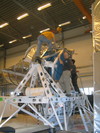
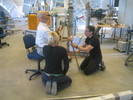
It's very early Saturday morning. Somehow, I've managed to get myself on the
night shift, which is by far the least exciting shift. (I'm the only one on it.)
During this time I've been working on removing some of the unpleasantries from
our commanding software. The original idea was we could run test flights during
the night, but that plan has been delayed by other issues.
Mark and Jeff opened the cryostat early yesterday, just about the time I was
going to bed. I slept through a fair chunk of the day, and when I returned
I learned the bad news: the mirror which we had thought misaligned was, in
fact, aligned properly. Not only that, but a full day of testing hadn't
got us any closer to figuring out where the problem lay. A few more ideas will
be tried today. In addition to the alignment conundrum in which we find
ourselves, we also discovered upon opening the optics box that one of the
filters has warped, which makes it unusable. Peter Hargrave, who designed the
optics, is arriving on Monday with a replacement filter.
If that wasn't enough, we've found more problems with the flight computers, and
Barth was forced to open the pressure vessel to debug them.
Thu 2005-05-19 15:13:01 UTC
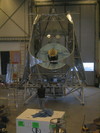
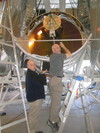
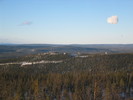
Thursday afternoon, and we're taking the gondola apart to extract the cryostat.
After the snow on Tuesday, Wednesday was clear and pleasant. The solar arrays
and batteries were mounted in the morning. NSBF managed to schedule some TDRSS
time for us so Enzo was able to test the beyond line of sight telemetry (uplink
and downlink) and it seems to be working. Mark also lead a troop to try and
map out how well the primary and secondary directed signal into the detectors.
This was done by putting a cold source (a bucket of liquid nitrogen) at various
places in front of the mirror and looking at the bolometer detectors to check if
they saw it. The results were disappointing: light hitting the entire top half
of the primary mirror is not getting to the detectors. Various theories were
suggested, the best one we came up with is that the front two legs that hold
up the optics box have broken and the optics box has fallen forward, which
seemed rather difficult to believe.
Somewhat discouraged, we had dinner and then Barth, Ed, Matt, Marie, Gaelen and
I walked up to Keops Hill, which is a little west and slightly higher than Radar
Hill. On our way back down we met Mark who was out for a run. He told us he
had figured out the problem: when reassembling the optics box, one of the
mirrors had been put in the wrong orientation. This cheered us up a bit, since
we now had a reasonable explanation. The decision was made to take the cryostat
out in the morning.
In the evening the cryogens were blown off from the cryostat to allow it to
start warming up. Ed and I did a few tests of the schedule file system,
discovering and fixing a number of bugs in the process. Also, Bert, one of our
data display computers had a hard drive failure, and I stayed up for a bit to
try and work on that.
This morning, before removing the cryostat, the gondola was rolled out the door
again to test to solar arrays and batteries. Results were promising, and the
arrays and the battery charge system seem to be working as designed. After
coming back inside, we began the long task of disassembling BLAST to get the
cryostat out. It's just been placed on the stand as I type this and will
be opened shortly. In the end, this likely hasn't cost us much in time, since
it's not clear that the pad will be ready before we're back together, middle
of next week.
Tue 2005-05-17 13:27:00 UTC
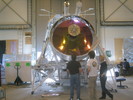
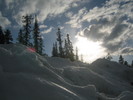
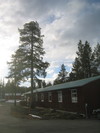
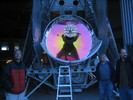
It's Tuesday afternoon and it's snowing again. We're slowly approaching flight
ready.
Barth and Enzo replaced one of the ACS cards yesterday morning due to a dodgy
watchdog circuit. New replacement seems to be working much better. Matt
painted the back of the solar arrays white yesterday, something that NSBF's
thermal analysis indicated was needed.
The sun shields went back on, hopefully for the last time before flight.
Gaelen, Mark and I then installed the "wings" on BLAST. With the loss of all
our competent people (viz. Jaspaul and Marco) I once again have an opportunity
to do such mechanical tasks, rather than just software and electronics.
We had our second preflight planning meeting and appear in good shape to be
flight ready this week.
In the evening we did the star camera alignment test again. This involved
installing a laser in the secondary and having it shine onto the top of Radar
Hill where Mark, David and Jeff could see it and shone a light back for the
star cameras to lock onto. Despite the cold weather, the procedure was
successful.
Today we've planned an Iridium test with the LDB guys. The chin has been
attached, which means an end to alignment checks of the cryostat. We'll also
hopefully attach the solar arrays and flight batteries today.
Sun 2005-05-15 22:47:46 UTC
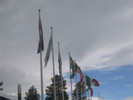
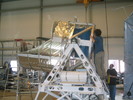
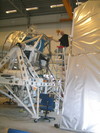
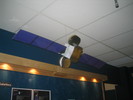
It's Sunday evening.
Saturday was spent installing and aligning the cryostat on the gondola, which
ended up being an all day affair. Once alignment had finished, the receiver and
DAS were also put on the inner frame and cabled up. I spent most of the day
chasing pointer errors in the ground station code.
Both the liquid helium and liquid nitrogen tanks were topped up today on the
cryostat. Following that, Barth spent a good deal of time debugging the ADC
board watchdog, which is still not working right. In the end, Enzo had to add
another capacitor to all the cards. I spent a bit of time helping. I also
worked out a termination procedure for the telescope for the end of the flight.
Chris needed this so he could work out the overall LDB termination procedure.
Marie, Gaelen and Matt remounted the star cameras. Gaelen wired up the inner
frame thermometers, and Matt mounted the Motorised Valve Box.
In the evening Matt, Ed, Gaelen and I (the Canadians) tried to find somewhere to
watch the World Cup Hockey final between Canada and the Czech Republic. It was
being broadcast on Sweden's Channel 3. Unfortunately the television in Hotel
Dagobert didn't have that channel so Ed investigated other places where we
might be able to get it. We considered going into Kiruna to find a bar where
it was being shown. However, after some investigation we learned that the
control centre for the communications satellite which broadcasts Channel 3 was
here at Esrange. So we went to the control room and were able to watch the game
there with the night staff whose job is to keep the satellite functioning and in
the correct orbit. Despite Canada's poor showing, it was an interesting
experience. It does seem a bit odd, however, that they can't pipe Channel 3
into Dagobert even though the room where they receive the satellite downlink
for distribution of the Channel to the rest of Sweden is in the building next
door.
Fri 2005-05-13 23:59:54 UTC
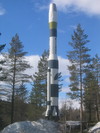

It's about half an hour before dawn on Saturday morning, which also means it's
about three and a half hours after sunset. At the "darkest" time of the night
we can make out Jupiter and sometimes Arcturus in the sky. Other than that,
it's as blue as day. There was a small amount of rain and hail in the
afternoon, but otherwise it was pleasant, if a bit cool. Barth took the day
off.
We rolled part of the way out of the door again today and did more TDRSS and
iridium tests. The TDRSS downlink seems to work as designed which is good news.
We also tested the Iridum uplink and downlink. We didn't get a chance to test
the TDRSS uplink, though, because we had to roll in due to rain and a bit of
hail before getting the chance. In the evening we tried to align the star
cameras to the sun sensor but ran out of time as Jupiter sank too low on the
horizon.
Fri 2005-05-13 00:08:48 UTC
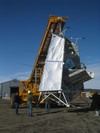
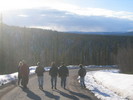
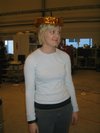
It's Thursday night, and it's started snowing and sleeting again, after a day or
two of really nice weather. It was sunny enough on Wednesday for us to go
outside to calibrate the Sun Sensor. We also took this time to calibrate the
GPS antennas, which basically means we got the GPS array to figure out the
relative orientation of the four antennas, something that is needed for it to
give us accurate attitude readings. We were out on the pad for most of the day.
After coming back in, all of BLAST except for Enzo and his wife walked up Radar
Hill and back down to get a bit of exercise.
Today Matt, Gaelen and I went into town for lunch and to shop for groceries, as
our strategic food supplies had become so dangerously low that it was uncertain
if we would be able to scrape together enough for lunch. We went to a cafe in
the centre of Kiruna which we enjoy called Safari. After lunch it was down to
the business of shopping, which ended up involving two grocery stores and a
liquor store. Marie had originally planned to go with us, but decided in the
end to stay at Esrange to help Mark and Jeff do bandpass tests on the cryostat.
In the evening Matt and I futzed around a bit with the Sun Sensor.
Wed 2005-05-11 00:30:34 UTC
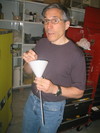
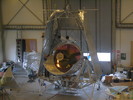
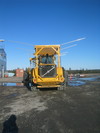
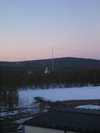
Technically, it's very early on Wednesday morning. After snowing some more on
Monday, Tuesday saw a dramatic shift in the weather: warm and clear, resulting
in something akin to spring runoff here at Esrange.
Monday was Marco's last day here at Esrange, he headed off early Tuesday morning
for Helsinki. Monday was other than that a slow day. The cryostat was in the
middle of the cool-down process, which meant little action in cryo corner other
than the occasional nitrogen fill. In flight code corner, Enzo continued to
flail away at the TDRSS problems. Along with the LDB guys, we seem to have come
to the conclusion that the problem is on NSBF's end and not ours, which allows
us to direct some of our attention elsewhere as we wait for them to work things
out, but it also is frustrating not to be able to really do much to go forward
with the issue ourselves.
In the past few days we have also been whacking away at a few remaining bugs in
the flight code. As part of this, Barth and Enzo have installed what is
hopefully the final version of the firmware in the ACS and the DAS. Gaelen has,
I hope, finally finished with the sun shield panel repairs, and he's been
working on gondola thermometry. Marie has been filling various things with
Dynalene.
Today we tried a few scan tests in the evening with mediocre results: it's
really too bright now to be able to see anything with the star cameras, even at
the darkest time of the day, just after midnight. Eric Klein, our liaison from
NSBF, arrived today.
Mon 2005-05-09 15:46:18 UTC
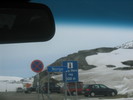
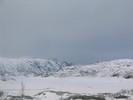

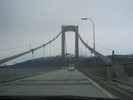
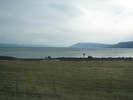
Sunday:
We got on the road shortly after nine. As there were six of us, we were
obligated to take two cars. We divided alphabetically by last name, so Gaelen,
Ed and Marie went in the Opal, while Marco, Matt and I were in the Volvo. We
took along the BLAST radios, which let us communicate between the two cars. Our
first destination was Abisko National Park, an hour or so west of Kiruna. Just
before eleven, we arrived at the village of Abisko, on the west edge of the park
and stopped for a rest. Brian, Chris and Nathan arrived not much later: we had
unexpectedly passed them a short while before reaching Abisko where they had
stopped on the road to take some pictures of Lake Torneträsk. We talked with
them for a few minutes in the parking lot and then they headed off for Narvik.
We hung around the village for a short while to wait for the convenience store
to open at 11. We also decided to skip the park, since it was still too cold
to spent all day outside. Instead we decided to head out to the fjords.
As is normal in Europe, the border crossing was trivial, and flagged by only a
few signposts and a customs building. More dramatic was the difference between
the plateau on which Kiruna is and the fjords on the west coast of Norway. As
we descended from the pass, not only was the snow gone and the temperature seven
degrees higher, but there were more trees, some of which were already budding.
We headed first to the town of Narvik, where we had some lunch and also
accidentally met up with the NSBF guys again. We walked around Narvik for a
bit but, it being Sunday, there wasn't much to do. After eating we decided
to head out north and west along the fjord for a while to see some more scenery.
The road we decided on was the E10, which runs from the Gulf of Bothnia in
Sweden, through Kiruna, and eventually to the Norwegian town of Å on the western
tip of Lofoten Island in the Norwegian Sea. From Narvik, we headed west along
the north shore of Ofotsfjord, which is the fjord which Narvik is on.
Ofotsfjord is a sub-fjord (if you will) of the great Vestfjord of northern
Norway. We crossed a bridge to one of the islands of Vesterålen. After
driving a bit further we decided to stop, lest we return home too late, along
the shore of the Vestfjord. The place where we pulled off the road happened
to have a small spit of land sticking out into the fjord, connected to the
mainland by an isthmus that would be underwater at high tide. Since the tide
was then low, and still going out, we had no trouble getting to the end of the
spit, taking some pictures, picking up some shells and returning to the cars.
After a sandwich break, we hopped back in the cars. This time we organised
ourselves alphabetically by first name, which put Matt, Marco and Marie in the
Opal (the "M" car) and Galen, Ed and I in the Volvo (the alphabet soup car?).
We got back to Esrange around nine at night, after stopping a few more times
to take some more photographs. All in all, it was an enjoyable time, although
it was kind of tiring.
Sun 2005-05-08 22:55:06 UTC
Well, we drove to Narvik and into Vesterålen a bit today. I have some pictures
and some more to say, but I think that'll have to wait for tomorrow when I'm
more awake.
Sat 2005-05-07 23:42:22 UTC
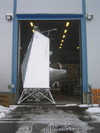
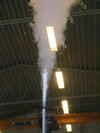
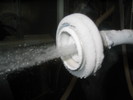
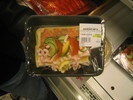
Saturday night. It finally stopped snowing, and the fog has lifted. We still haven't seen any sky, though, since Monday. Barth, Matt and I went in to town
today for groceries. We were also trying to find a few computer parts, but
the computer store closed before we were able to, so we'll have to go back
Monday.
Enzo spent most of the day working with the NSBF guys to try and debug our
TDRSS problems. They made a little progress, but there's still more work to
do. I kibitzed a bit. The cryostat was warmed up. After dinner, Gaelen, Ed,
Barth, Marco and I went to the lounge and played a few games of pool, while
the rest of the team returned to the highbay, opened the cryostat, fixed the
heatswitch heater, and closed the cryostat back up again. It now has to be
pumped down again in order to be ready to cool down again.
Gaelen, Ed, Marco, Marie, Matt and I have made plans to take tomorrow off and
go traveling a bit.
Fri 2005-05-06 21:28:29 UTC

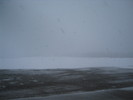
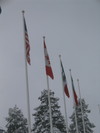

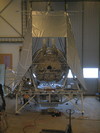
It's Friday night. It's been a rather busy day. I've been trying to get this
article written all day with little success. It finally stopped snowing late
this afternoon after two days of incessant snow. This morning I went out to the
pad and took some measurements of the accumulated snow since Monday afternoon.
The result: 175 mm or about 7 inches.
We discovered yesterday that the heater on the heatswitch inside the cryostat
has stopped working, which meant we couldn't turn it on. This, in turn meant
we couldn't quickly cool down. The heatswitch does for heat what an electrical
switch does for electricity: when the heatswitch is "on", the two things that
the heatswitch connects are in thermal contact, so they can transfer heat between
themselves. When the heatswitch is "off", the two things are thermally
isolated. The heatswitch is turned "on" by heating it up and turned "off" by
letting it cool down. So, normally the heatswitch is turned "on" by heating it
when we're cooling the cryostat so that something that's cold (in this case the
liquid helium tank) can easily cools something that is warm (the He4 pot).
However, because the heatswitch heater is broken, the heatswitch is stuck in
the "off" position, which means, even though the liquid helium tank is really
cold, the He4 pot can only cool very slowly. The day was spent by Mark and Jeff
trying to coax these warm parts of the cryostat to cool down more quickly.
Today, the heatswitch started working again, indicating some flaky electrical
connection between the heatswitch heater and the outside world. Later today,
after getting things cooler, but not nearly as cool as we wanted them to be, the
decision was made to heat up the cryostat and try to figure out what caused the
heater to stop working. So the cryogens have been blown off and things are
starting to warm up.
Gaelen and Marco spent most of yesterday ripping off the old tape, fixing up
the Mylar and otherwise repairing and refitting the last of the sun shield panels
yesterday. Today the main part of the sun shield was finally mounted on the
gondola, complete except for a few of the panels which remained off to give us
easier access to the gondola. Since then, Gaelen has been working on the
gondola thermometry and Marco has been designing inserts to fill the holes that
were made in the mirror for the old secondary mount.
Yesterday we switched over from using the SIP Simulator to using the SIP itself.
This means all of the commands we send up to the gondola, as well as our TDRSS
telemetry is now in flight configuration and being transmitted through the air,
rather than over cables which we had strung to the gondola. Today Marie and I
worked with the Chris for a while to get the science stack working. The
science stack is a special bit of electronics provided to us by NSBF. We need
it to turn on and off all of our various electronics components. Naturally,
when all our stuff is off, we can't use our normal commanding (via the SIP) to
send and commands since there's nothing on the gondola that can receive them
(the computers being off). So, the science stack is essentially what we use
to "bootstrap" BLAST into operation.
More NSBFers have been arriving in the past few days. Among them are the
electronics guys. They have given Marie the video and data transmitters, and
she has mounted them on the gondola. We'll try them tomorrow to see if they
work.
The pressure vessel was also closed up to day finally and leak checked.
After that we tried a few simplistic scan tests to see how much of BLAST we
had inadvertently broken while fixing everything else. The answer: not much.
Wed 2005-05-04 21:05:12 UTC
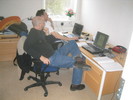
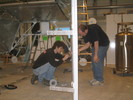
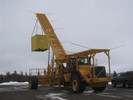
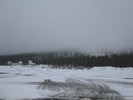
Wednesday evening. It's snowing again, after being rainy and foggy all day.
Gaelen and numerous deputies spent Tuesday evening attaching panels to the
sun shield frame. All that was left was for Chris to attach the TDRSS antenna
before we stood it up, something that he did Wednesday morning. Those of us
inclined to eat meat had a feast Tuesday evening. Enzo prepared a reindeer
rump roast and Jaspaul made a pile of tandoori chicken. It was all excellent.
This morning the SIP was installed on the gondola, but we weren't able to get
switched over to it from the SIP Simulator before the LDB guys finished for the
day. Marco and Marie spent most of the day filling in the gap between the
mirror and the scoop with mylarised foam and conductive tape to make an RF seal.
A couple of helium transfered occurred throughout the day as the cryostat
continued to cool. Enzo and I measured some receiver transfer functions before
lunch. The riggers spent some time getting familiar with the new launch
vehicle.
Essentially all of the MASER 10 people have left now, and so we're the only
scientific group here now. We learned that Dagobert, our home here at Esrange
had been sold out from under us. In about a week and a half we have to move
into Hotel Dilbert, the new and incomplete hotel as the old dorms, Hotels
Albert, Herbert and Dagobert, are being retired.
We're slowly getting into flight configuration. Right now, Matt's remaking the
Magnetometer cable (the old one is too short), Enzo is securing the ACS to the
gondola and Marco and Marie are covering the new mirror cover (aka the Millennium
Falcon) with tissue in preparation for installation on the mirror. Having no
more flight code to write, Barth's abandoned flight code corner for his office.
Tue 2005-05-03 16:27:31 UTC
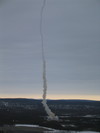
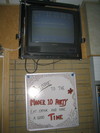

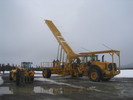
It's Tuesday afternoon. It's been snowing for about 24 hours now.
The MASER 10 launch happened Monday morning around 7. It was the last Skylark
sounding rocket in existence, so the launch was the end of an era. I have a
launch video for the interested. Both Gaelen and
Jaspaul managed to get
some good photographs. Unlike our missions, the Maser 10 mission seemed to be
over almost as soon as it launched: they were already doing recovery of the
payload by the time we got back to the Cathedral from Radar Hill and down to
work. As the day progressed we learned of some bad news from the Maser team:
the drogue chute had opened, but the main chute had not. So, the payload was
now a pancake somewhere north of us. Three of the five experiments got all
their data during the flight, but the two biological experiments on the rocket
require the recovery of their samples. Nevertheless, after finding and
recovering the payload, it looked like these experiments may be able to salvage
their data as well.
Monday afternoon it started snowing and we had an integration planning
meeting to identify issues that needed to be addressed before launch. In the
evening we attended the Maser 10 post-flight party. There were several speeches
made, including one by Hugh Whitfield, who co-ordinated the Skylark integration.
The party ended rather late and I got to bed sometime after four.
This morning guys from Esragne brought by and assembled the launch vehicle,
which they have named Hercules. It was assembled and then taken out for a test
drive. It's large and yellow. I spent some time working on some of the flight
software improvements which were identified at the meeting. Gaelen, Matt, Marco
and Marie continued to mylarise the sun shields and attached the panels to the
sun shield frame.
Sun 2005-05-01 19:52:03 UTC
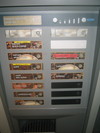
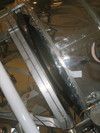

Sunday evening.
Most of us have already left and turned in for the night, since we have to meet tomorrow at 5:40 to go out to watch the launch. The good news for the weekend
is that the indium seal that Mark and Jeff fixed on Saturday seems to have fixed
the leak. The cryostat was cooled down today. Barth and I worked on getting
the pressure sensor in the pressure vessel calibrated, in preparation for
closing up the PV. Enzo finally managed to get the TDRSS ground station
software working. Barth also fixed a few other pointing bugs.
Sun 2005-05-01 08:08:27 UTC
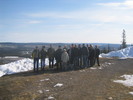
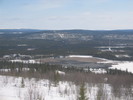
It's now about 10 am on Sunday. The rocket launch has just recently been
scrubbed.
Around five after nine we had the ten minute warning of the resumption of
countdown. We loaded up in the cars and headed back to Dagobert to collect
the remainder of the contingent. Chris and Nathan joined us, which gave us
three cars, enough to transport everyone. We took the road up to the Radar
Hill, where a bunch of other spectators had gathered. As soon we got there,
we realised we had left Ed behind. Marco and Marie headed back down to see if
they could find him. The countdown continued until T minus 25 minutes, when it
was paused again. We milled about a bit, taking a few pictures and looking at
the radar building. Eventually the launch was called off completely. Ed showed
up then, getting a ride up with our Esrange publicist. We all turned around
and went back to work. Another four and a half hour countdown been scheduled to
start tomorrow at 2 a.m.
Sun 2005-05-01 06:23:44 UTC
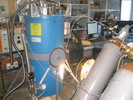
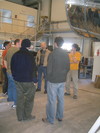
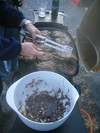
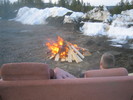
It's currently Sunday morning, we're waiting for word on the MASER 10 launch,
which is holding at T minus 45 minutes due to high ground winds.
The announcements and warning horns that accompanied the hot countdown test
entertained us all Saturday morning. The tightening that was done on the indium
seal Friday proved to be insufficient to stop the leak, so Saturday was spent
warming up and opening the cryostat again in order to replace the indium seal
this time. David Hughes arrived from Mexico in the early afternoon. Gaelen and
Marco attached the mylarised foam panels to the sun shields in order to assess
the panels that had to be remade. Thomas came by and told us the launch
countdown would begin at 2:30 tomorrow morning, which would put launch around
7 am. From T minus 30 minutes until after launch we are not allowed in the
highbay or outside near it. Our options are either to stay inside the hotel
or else go out to the Radar Hill where we can watch the launch.
For dinner, Enzo and Matt grilled some reindeer which had been marinating all
day. The result was tasty, but not as successful as Friday's stew: reindeer is
difficult to barbecue. On our way back from dinner we happened across the
Swedish contingent deputed to light the Walpurgis night fire, which we hung
around to see the start of.
Having to be up on the Radar Hill at least half an hour before launch, we
agreed to meet in the kitchen at ten after six this morning, which,
surprisingly, everyone managed to do. Having the count-down start at 2:30
meant loud P.A. announcements all night. The first announcement, right at 2:30
informed us that launch would be delayed an hour. This morning, shortly after
we all met in the kitchen, launch control announced that the countdown would be
holding at T minus 45 minutes due to winds. And not much has happened in the
following two hours... According to the MASER 10 site, the latest they can
launch is 11 am, four hours after the scheduled launch. That gives us a little
bit more than an hour until we discover if they scrub or not.
Sat 2005-04-30 20:56:58 UTC
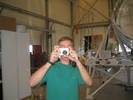
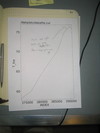
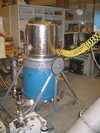
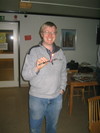
Friday:
The cryostat was opened up, the indium seal on the base of the helium tank
tightened down, and then the cryostat closed up again. This took most of the
day for those of us on cryo duty. It was Barth's birthday today. He, Greg,
Marco and Jaspaul took the day off and drove to the Norwegian coast, about
four hours west of here to take in the fjords. They returned just before
dinner. Ed and Enzo made a stew from some reindeer meat we had purchased in
town. A hot countdown test is scheduled for tomorrow for the Maser 10 rocket,
and the launch is Sunday morning.
Fri 2005-04-29 15:38:44 UTC
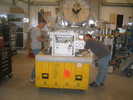
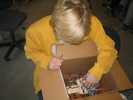
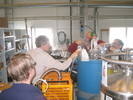
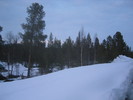
Thursday:
The NSBF guys arrived today. Chris and Nathan, who are responsible for the SIP
and the ground station equipment, set up and got to work on getting the
electronics ready for the flight. Marie took off and opened up one of the Star
Cameras to fix the focus positioning. In the afternoon we discovered a
cold-only leak in cryostat. Eventually we resigned ourselves to warming up in
an attempt to figure out where it is and fix it. The leak only shows up at
Liquid Helium temperature, which makes debugging the problem very difficult.
So, Matt found the dewar warmer and the slow process of warming up began.
Fri 2005-04-29 13:07:46 UTC
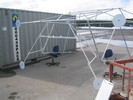
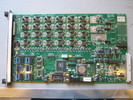
Wednesday:
The top of the sun shields were painted in the morning, which meant removing the
GPS antennas first. Ed arrived today from his travels in Italy. Replacement
resistors arrived which allowed Enzo and Barth an opportunity to finally fix the
problems with the hardware watchdog on the ADC cards.
Wed 2005-04-27 20:33:57 UTC
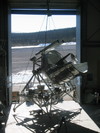
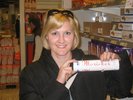
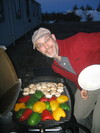
Tuesday:
The sun sensor was calibrated in the morning. Jaspaul, Gaelen, Marie, Matt and
I went into town for lunch. It was also time to stock up on more groceries, so
we did that. The GPS antennas were attached to the sun shields. In the evening
we had a barbecue using a gas grill which Esrange provided for us.
Tue 2005-04-26 17:56:23 UTC
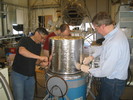
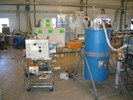
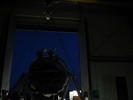
Monday:
The cryostat was closed up and pumped down for the last time before flight. In
the evening we did star camera tests.
Gaelen has put up a photo log of his own at http://www.physics.ubc.ca/~gmarsden/kiruna_2005/, which everyone should
check out.
Mon 2005-04-25 13:48:19 UTC
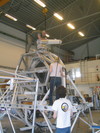


Sunday:
The star cameras and the baffle were mounted today. The cryostat was warmed up.
For lunch, Marie, Matt and I went into town. On the way there, we encountered
a herd of reindeer on the road. They had a propensity to run down the middle of
the road when encountering a car, instead of, say getting off the road. It
being Sunday, about a third of the restaurants were open. We had lunch in a
small cafe in central Kiruna. Marie randomly ordered a quiche, Matt and I had
large-aspect-ratio sandwiches. Marie also managed to find a candy store.
In the evening we tried to find the offset of the star cameras to the primary
beam. We did this by placing a laser on the back of the secondary and then
pointing the telescope towards a building on a hill on the other side of the
pad. Mark and Jeff went over to the hill and then shone a light back at us
where the laser shone.
Sun 2005-04-24 08:55:26 UTC
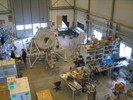


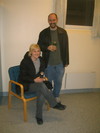
Saturday:
The cryostat was mounted today and many of us spent the day working on aligning
it. Barth and Enzo debugged a problem with the watchdog on the ADC cards. I
spent a bit of time with Marie checking that the star cameras still worked with
the rest of the gondola. In the evening the cryostat was removed and emptied
and then we went to the main building to play pool and table tennis.
Sat 2005-04-23 13:04:35 UTC
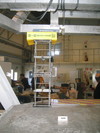
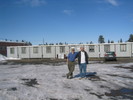

Friday:
Enzo did his gyro rotation tests today. Barth took apart the Charge Controllers
and replaced some resistors to give us better control over charging the
batteries during flight. In the early afternoon Mark and one of the MASER 10
guys exchanged talks. MASER is a scientific rocket which will be launched from
Esrange at the end of May. The cryostat was closed up and pumped down, which
involved popping two windows. The third one held, however. We mounted the
mirror after this and then had to knock off for the party that they had been
preparing outside. Later the cryostat was cooled down. In the late evening I
partially took apart the ACS to tighten some screws that had gotten loose.
Fri 2005-04-22 14:07:25 UTC
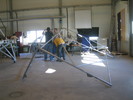
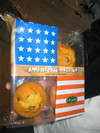
Thursday:
Barth, Enzo and I spent some time working on the tilt sensors, in an attempt to
use them to level the outer frame in preparation for the gyroscope tests that
Enzo needed to do. During this we discovered that one of our tilt sensors was
dead. Not a big problem, since there's another one that measures the same thing
and it's not actively used during flight for pointing. Nevertheless we looked
into getting another shipped out here. We also discovered some noise in the
tilt sensors that seemed to be RF pickup on the power lines, and we took some
steps to reduce it, which meant we had to disassemble the ACS again. Gaelen and
company started assembling the sun shield frames, and then looked at what had to
be done to repair or replace the Mylar-and-foam sun-shield panels. Marie took
apart the star cameras and inspected them. Enzo and Marco graciously agreed
to cook dinner for us all.
Thu 2005-04-21 12:20:24 UTC
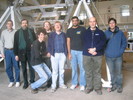
Wednesday
In the morning 130 or so ambassadors to Sweden came through on a tour of the
base. Barth gave a short speech to them and then the Canadians here got the
chance to meet the Canadian ambassador to Sweden.
Enzo and Greg inspected the ACS and, once it was back together, put it on the
gondola. We then were able to power up the flight computers. I spent most of
the rest of the day getting our support computers up and running and getting
the telemetry running. This meant setting up the bit sync, Arwen our
line-of-sight groundstation computer, and the SIP simulator. In the course of
this I discovered a bad card in arwen that required Enzo's expertise in
soldering. This in turn meant setting up the soldering station, which required
getting one of the variacs working to convert from European 220 to North
American 115 volt power. After soldering the card, however, we found it was
still bad. Fortunately we had a spare and that worked. Mark, Jeff, Marie and
Matt arrived in the afternoon with the last bolometer array. They got right
down to the business of installing it.
Thu 2005-04-21 12:20:24 UTC
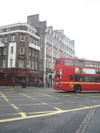
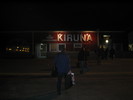
Monday evening and Tuesday:
Barth and I left Toronto in the early evening, bound for London on an Airbus
A340. The plane was full and the trip was uneventful. We arrived at Heathrow
shortly after six in the morning and got through passport control and to the
departures lounge in Terminal 3 by seven. As far as I can tell, what happened
when they made the departures lounge of Terminal 3 is they built a shopping
mall, and then sort of stuck an airport in the left-over spaces. Unfortunately
our flight to Stockholm didn't leave until after one. I thought I might go into
town for a few hours, just to kill some time. Barth reluctantly decided to stay
in at the airport and work on his proposal.
Getting out of the airport required me to go the wrong way through one
passport control (for connecting travelers) and then back into another passport
control, this one for people entering the UK. This required another wait in
the queue, and it was just after 8:30 when I got to the Heathrow train station,
and I made it to Paddington Station around nine. I had a bite to eat and then
went on Don's Extremely Short Tour of Downtown London:
- Take the tube to Picadilly Circus
- Walk down Haymarket and Pall Mall to Trafalgar Square.
- Cross Trafalgar Square and head down Whitehall to Parliament.
At this point it was time to return to the airport. So I turned around and made
it back to Paddington Station just in time to catch the 11:00 train back to the
airport. I reunited with Barth in the departures lounge and we eventually got
on our MD-80 aka. DC-9 to Stockholm. This plane was full too. I had the window
seat in row 31, which put the cowl of one of the engines directly beside me.
Barth sat directly behind me, which gave him an even worse view from his window.
We landed at Arlanda airport in Stockholm just after five, and found
ourselves with another three hours to wait before the final leg of our journey.
Here we had to go through passport control again, and then collect our checked
luggage for the trip past (not through) customs. After changing terminals we
re-checked our luggage and then wondered about something to eat. I went to a
bank machine and withdrew a random amount of money, having not bothered to
check the exchange rate beforehand. We got something to eat and then settled in
for our wait, while keeping an eye out for Gaelen, who was supposed to be on our
flight.
We boarded the flight shortly before nine at night, at which point we had
spent more time since taking off from Toronto waiting for flights than actually
flying. We were both fortunate to be seated in the front of the plane, another
MD-80, again full. (SAS seems to own about a million of them.) Gaelen rushed
onto the plane just as they finished boarding—obviously he had had shorter
layovers than us.
The flight out of Stockholm stopped first in Umeå where about half of the
passengers got off. The rest of us continued on to Kiruna where we arrived
sometime after 11 at night. It was mostly dark, except for the northern
horizon, where it was dawn or dusk, depending on your point of view. Marco
was waiting for us at the airport and he drove us to Esrange, where the three
of us had a bit of lunch and then headed gratefully to bed.
© 2005 D. V. Wiebe.
Last generated Tue 2025-07-01 00:11:37 UTC







































































































































